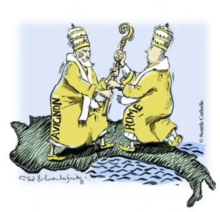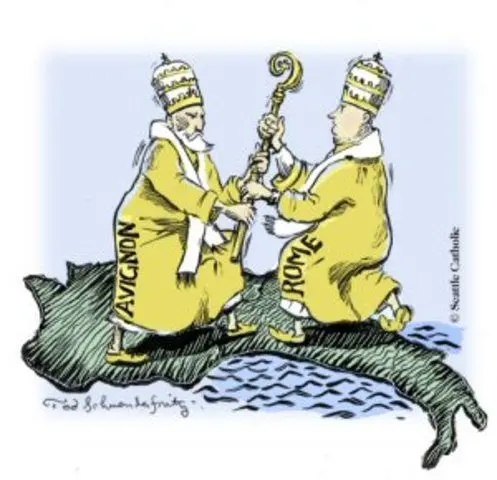
by Ivan C, Year 12
Imagine, if you will, that you are Pope Boniface VIII. You have been elected to the papal office, and you are one of, if not, the heaviest-hitter in the politics of Western Europe. It is an autumnal night in September 1303, and the moon dimly lights the city of Anagni, where you reside for the summer. But, the peace and quiet of this Medieval Italian town will be disturbed soon enough. You are woken in the night to see hundreds of men, having passed through the gates of the city with the help of a traitor, approaching your papal palace. This is not good news. You have been skirmishing with the French king Philip IV and you have both been trying to undermine each other’s power politically for years. You have levied taxes upon him and targeted him with papal legislation, but with the arrival of Frenchman at your holiday home, it appears that he has taken the first step to oust you from power - permanently. Deep panic begins to set in. All but two of your cardinals have deserted you. The sound of metal on metal, crescendos louder and louder, the tension building.
Boniface didn’t really have much of a choice in this situation. He managed to negotiate a nine hour truce with Colonna, the leader of the aggressors, in the hope that the townspeople would come to his aid. This does not come to fruition, and Boniface resigns himself to his pontiff chambers, while his house is ransacked and pulled apart, accepting his death.
However, Boniface would not die that night. Some scholars argue that he was beaten and died of his injuries a month later. Some suggest that he simply died of natural causes. Regardless, the death of Boniface was brilliant news for Philip IV, who following the convenient death of Boniface, pressures the new Pope, Clement V - who was also French himself, to move the Papacy out of Rome. Clement V was also partially motivated by growing factionalism in Rome. Regardless of the significance of factionalism in Clement making his decision, where he moved the Papacy to is most striking. Clement decided to move the Papal palace to Avignon, in South western France. The Pope was now under control of the French crown. What also illustrates that Clement was not motivated by factionalism in Rome, was, having been made Pope, Clement flooded the college of Cardinals with French cardinals, creating a majority of French cardinals, ensuring the succession of the Papacy through a French line. This move by Clement, paired with the upheaval of the catholic Church, were both moves to consolidate the power of the French crown over the Papacy. Clement did not move out of fear of politics, he did so because of Papal Politics (Papal Bull).
Whatever the motivations, the Church lost a great deal of prestige as a result of Clement’s move, arguably paving the way for the establishment of Lollardy in Britain in the late 12th century. The weakening reputation of the Church’s image as an honest and uncorrupt organisation naturally led to proto-protestant movements that called for reform in the western Catholic church, especially among nations that were not under French influence, but remained catholic, such as England and Germany.
The Pontificate remained in Avignon, under the thumb of the French crown for the terms of 7 Popes, until 1376 when Pope Gregory XI finally returned the papacy to Rome. However, he died within two years of returning. As expected, a conclave was created to elect a new Pope. However, a Roman Mob stormed the Vatican while the election was taking place, calling for “A Roman Pope, or at least an Italian one.” The enclave then elected the Roman Pope Urban VI. Urban believed that the cardinals had accumulated far too much power, and so was very hostile to the college. Quickly regretting their decision, thirteen cardinals fled back to Avignon, and elected Robert of Geneva as Pope Clement VII. Thus the schism began. Attempts to repair the break in the church all failed. A solution was proposed that was based upon the conciliar movement, the belief that the pope should be subject to powers held by a larger council. Both Popes, wishing to maintain their authority, rejected this proposal. The cardinals of both Popes, abandoned their leaders, and arranged the council of Pisa, which in 1409, attempted to resolve the schism by electing another Pope. This did not work. It only exasperated problems. Following the prompt death of this new pisan pope in 1410, a new pope was elected in Pisa - John XXIII. John proposed the Council of Constance, which convened in 1414. This council was also endorsed by the Roman Pope Gregory XII, legitimising it, increasing its chances of being successful. John, the Pisan Pope passed a law that gave the council the highest authority in the catholic church, with the power to remove Popes. The council deposed John (Pisan), received the resignation of Gregory (Roman) and dismissed the claims of Benedict (Avignon). The council, in one fell swoop removed all existing popes and antipopes, paving the way for the election of Martin V in November 1417, ending the schism.
The consequences of the schism and the events preceding it were immense. Firstly, having a pope under the control of a Foreign king to such an extent that the entire papacy is moved out of its historical home, was not a brilliant look for the prestige of the pontificate. Secondly, the schism itself was disastrous for the catholic church. The Great Western Schism has been linked to the rise of proto-protestant movements such as lollardy, and the reformation itself. This connection makes sense. The Papacy was deeply undermined by itself in this period - three times. Naturally, people around Europe began to question the divine right of the pope, if there were three claiming this right at once, eventually leading to the rise of Protestantism and eventually the Reformation.






























